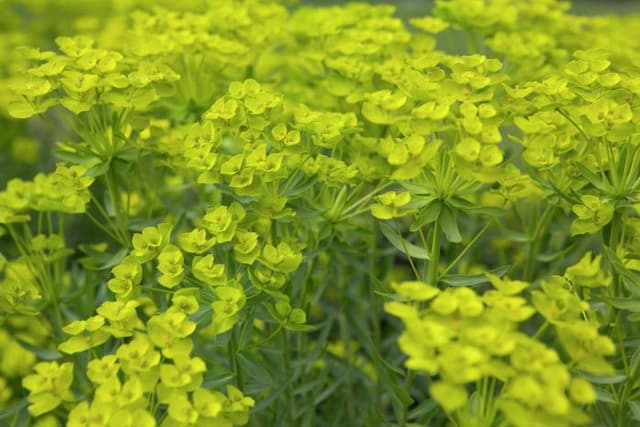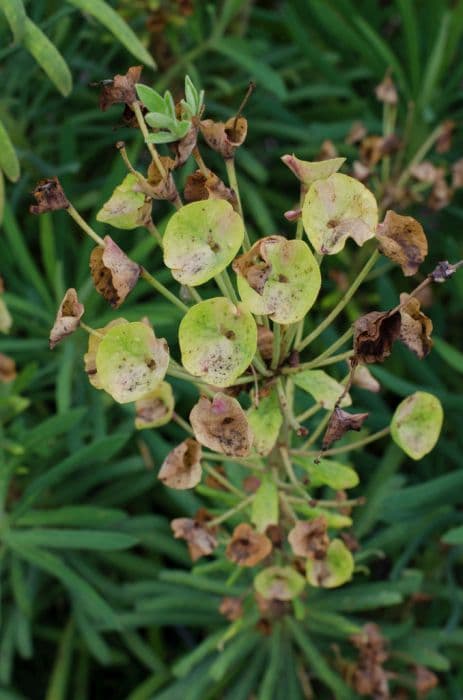Fringed Spurge Euphorbia fimbriata

ABOUT
Euphorbia fimbriata, commonly known as the Fringed Spurge, is characterized by its unique and attractive appearance. This plant typically boasts a sprawling growth habit, extending outward with branches that may bear a resemblance to coral due to their intricate patterns and shapes. The stems of the Fringed Spurge are slender yet robust, often taking on a green to reddish-purple hue that adds to the visual interest of the plant. The leaves of the Fringed Spurge are equally noteworthy, with a narrow lanceolate shape that tapers to a point. They present a vibrant green color, with edges that might be delicately serrated or appear finely fringed, aligning with the plant's common name. The foliage can also exhibit variegation in certain varieties, showcasing a mix of lighter and darker greens that create a textured effect. Flowering in the Fringed Spurge is a subtle but notable event, where small flowers emerge nestled within specialized structures called cyathia. These flowers are typically unassuming in color, ranging from yellow to green, but their arrangement within the plant’s overall structure provides an additional layer of aesthetic appeal. The Fringed Spurge’s overall form and branching pattern give it a bushy, dense appearance, which makes it stand out in garden settings or when cultivated as a houseplant. The combination of its richly pigmented stems, ornate leaves, and understated flowers results in a plant that is both striking and sophisticated, able to capture the interest of plant enthusiasts and casual observers alike.
About this plant
 Names
NamesFamily
Euphorbiaceae
Synonyms
Fringed Spurge
Common names
Euphorbia fimbriata.
 Toxicity
ToxicityTo humans
The Euphorbia fimbriata, commonly known as the Fringed Spurge, is toxic to humans if ingested or if its sap comes into contact with skin or eyes. Like other Euphorbias, the Fringed Spurge contains a milky sap (latex) considered a skin and eye irritant. The sap contains chemicals that can cause intense inflammation. If the sap gets into the eyes, it can result in pain, redness, swelling, and possible temporary or permanent vision problems. Contact with the skin may cause redness, itching, rash, and blisters. Ingesting any part of the plant can cause symptoms like burning sensations in the mouth and throat, abdominal pain, diarrhea, and vomiting. People with latex allergies may have more severe reactions. Care should be taken to avoid contact with the sap, and wearing gloves or protective clothing is advisable when handling the plant.
To pets
The Euphorbia fimbriata, commonly known as the Fringed Spurge, is also toxic to pets. As with humans, the primary concern is the toxic milky sap that the plant produces. If pets come into contact with the sap, it can cause skin irritation, including redness, itching, and swelling. If the sap gets into their eyes, it can lead to pain, inflammation, and possible damage to the cornea. If a pet ingests any part of the Fringed Spurge, likely symptoms include vomiting, diarrhea, drooling, and possible difficulty swallowing due to irritation of the mouth and throat. In severe cases, ingestion may result in more serious symptoms and require veterinary attention. Pet owners should prevent their animals from chewing on or ingesting any part of the plant.
 Characteristics
CharacteristicsLife cycle
Perennials
Foliage type
Evergreen
Color of leaves
Green
Plant type
Succulent
Benefits
 General Benefits
General Benefits- Drought Tolerance: Euphorbia fimbriata is highly resistant to drought, making it suitable for xeriscaping and water-efficient gardens.
- Low Maintenance: This plant requires minimal care once established, making it a good choice for gardeners with limited time or those new to gardening.
- Attracts Pollinators: Its flowers can attract beneficial insects, such as butterflies and bees, which are important for pollination in the garden.
- Landscape Design Versatility: Due to its unique structure, it can be used in a variety of landscaping themes, from modern to rock gardens.
- Erosion Control: Its root system helps to stabilize soil, which can prevent erosion on slopes and in other vulnerable areas.
- Long Blooming Season: Euphorbia fimbriata has a lengthy blooming period that provides visual interest throughout multiple seasons.
- Heat Resistance: It thrives in hot conditions, which makes it suitable for climates that experience intense summer heat waves.
- Deer Resistance: This plant is not typically favored by deer, reducing the likelihood of damage in areas with deer populations.
 Medical Properties
Medical PropertiesThis plant is not used for medical purposes.
 Air-purifying Qualities
Air-purifying QualitiesThis plant is not specifically known for air purifying qualities.
 Other Uses
Other Uses- Euphorbia fimbriata, commonly known as the Fringed Spurge, can be used in landscaping as an ornamental plant due to its distinctive foliage and growth pattern.
- Euphorbia fimbriata serves as a host plant for certain species of butterflies, making it beneficial for butterfly gardens and supporting local ecology.
- The sap of Fringed Spurge has been used traditionally as a fish poison in some cultures to stun fish, making them easier to catch.
- The unique texture and form of Fringed Spurge can be incorporated into floral arrangements for a touch of exotic appeal.
- In arts and crafts, the sap can be used as a natural adhesive for small projects when no toxic strength glue is required.
- Euphorbia fimbriata can be used in educational settings such as schools and botanical gardens to teach about plant defense mechanisms due to its toxic sap.
- The Fringed Spurge is sometimes used in creative photography to add a surreal or alien-like element to images because of its unusual appearance.
- Euphorbia fimbriata has been used in some cultures for marking livestock with its sap to create a temporary identifier.
- In outdoor survival scenarios, the Fringed Spurge might be used as a temporary caulk or sealant for small leaks due to its sticky sap.
- Connoisseurs of rare plants might cultivate Euphorbia fimbriata as a collectible item, valuing its unique aesthetic among other plant species.
Interesting Facts
 Feng Shui
Feng ShuiThe Euphorbia fimbriata, commonly known as the Fringed Spurge, is not typically used in Feng Shui practice.
 Zodiac Sign Compitability
Zodiac Sign CompitabilityThe Euphorbia fimbriata, commonly known as the Fringed Spurge, is not used in astrology practice.
 Plant Symbolism
Plant Symbolism- Resilience and Adaptability - Euphorbia fimbriata, commonly known as the Fringed Spurge, often survives in tough environmental conditions, symbolizing the ability to endure and adapt.
- Protection - The plant's sap is toxic and can cause irritation, symbolizing defense and the need to protect oneself from harm.
 Water
WaterThe Fringed Spurge should be watered thoroughly, allowing the soil to dry out between waterings. Typically, watering every 7 to 10 days during the active growing season (spring and summer) with about 16 ounces of water should be sufficient. During the dormant period in fall and winter, reduce watering frequency to once every 2 to 3 weeks, ensuring that the top inch of soil is dry before adding another 16 ounces of water.
 Light
LightFringed Spurge thrives in bright, indirect light but is tolerant of some direct sunlight, especially in the cooler hours of morning or late afternoon. Place the plant in a well-lit room where it can receive plenty of light without being exposed to harsh midday sun.
 Temperature
TemperatureThe ideal temperature range for Fringed Spurge is between 60 and 75 degrees Fahrenheit. The plant can tolerate a minimum temperature of approximately 50 degrees Fahrenheit and a maximum of around 85 degrees Fahrenheit, provided that it is not exposed to sudden temperature changes.
 Pruning
PruningPruning Fringed Spurge is generally performed to remove any damaged or diseased parts and to maintain plant shape. The best time to prune is in late winter or early spring before new growth begins. Perform light pruning as needed, and more extensive pruning should be done every couple of years to rejuvenate the plant.
 Cleaning
CleaningAs needed
 Soil
SoilFringe Spurge thrives best in a well-draining soil mix composed of cactus potting mix supplemented with perlite or pumice for increased aeration. A suitable pH for this plant is around 6.0 to 7.5, slightly acidic to neutral. When preparing your mix, ensure it allows for quick drainage to prevent root rot.
 Repotting
RepottingFringe Spurge should be repotted every two to three years to ensure it has enough room for growth and to replenish the nutrients in the soil. Choose a pot only slightly larger than the current one to prevent excess moisture retention in the soil, which could lead to root issues.
 Humidity & Misting
Humidity & MistingFringe Spurge, like many euphorbias, prefers a relatively low humidity environment, making it well-suited to typical indoor conditions. The best humidity level for this plant is between 30% to 50%.
 Suitable locations
Suitable locationsIndoor
Place Fringe Spurge in bright, indirect light and avoid overwatering.
Outdoor
Grow Fringe Spurge in partial shade with protection from intense sun.
Hardiness zone
9-11 USDA
 Life cycle
Life cycleEuphorbia fimbriata, commonly known as the Fringed Spurge, starts its life as a seed that germinates in warm, moist soil with sufficient light. Upon germination, it develops a root system and a small rosette of leaves. As the seedling matures, it grows into a succulent plant with a semi-upright stem and distinctively fringed leaves along the edges. The plant reaches maturity and produces inconspicuous flowers surrounded by showy, petal-like bracts, typically in spring or early summer. After pollination, typically by insects, it develops small, three-lobed fruit capsules that explosively release seeds when ripe. These seeds disperse into the surrounding environment, beginning a new life cycle if conditions are favorable.
 Propogation
PropogationPropogation time
Spring-Early Summer
Euphorbia fimbriata, commonly known as the Fringed Spurge, is most commonly propagated through cuttings. The ideal propagation time for this plant is during the warm months of spring through early summer, ensuring the cuttings have the best conditions for root development. To propagate, a healthy branch is selected and cut with a sharp, clean knife or pruning shears, making sure the cutting is about 4 to 6 inches (10 to 15 centimeters) long. The sap should be allowed to dry and callous over for a few days to reduce the risk of rot. Once calloused, the cutting can be planted in a well-draining soil mix. It is critical to keep the soil lightly moisturized but never soggy and to provide warm temperatures and indirect sunlight until roots have established and new growth is visible, indicating successful propagation.









